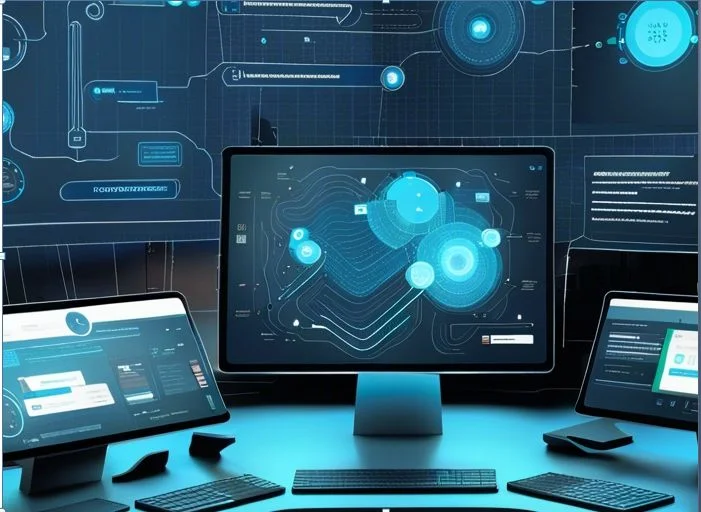Introduction
Headless commerce involves separating the front-end customer experiences from the back end of an ecommerce site. This decoupling allows businesses to deliver flexible content across various platforms, such as websites, apps, kiosks, and IoT devices. Brands gain full creative freedom while developers can build bespoke ecommerce experiences using their preferred technologies.
The significance of headless commerce in today’s ecommerce landscape cannot be overstated. It empowers brands to create seamless omnichannel experiences, enhancing customer interactions at multiple touchpoints. As we look ahead to 2024, headless commerce is poised to shape the future of ecommerce by offering unprecedented flexibility and customisation options.
This complete guide will cover:
- Understanding Headless Commerce: A comprehensive definition and exploration of key elements.
- Benefits and Advantages: Flexibility in content delivery, creative freedom, and unique customer journeys.
- Embracing Omnichannel Retail: Enabling seamless experiences across different channels.
- The Architecture Behind Headless Commerce: Insights into front-end presentation layers and back-end operations.
- Exploring Shopify’s Headless Solutions: An overview of Shopify’s approach and its benefits for merchants and developers.
- Key Considerations for Implementation: Factors to keep in mind when adopting a headless strategy.
- The Future of Commerce: The potential implications of headless commerce for businesses.
By understanding these facets, you can leverage the benefits of headless commerce to drive business growth in 2024 and beyond.
Understanding Headless Commerce
Headless commerce refers to the decoupling of the front-end and back-end aspects of an ecommerce platform. This separation allows for a more flexible and dynamic approach to delivering content across various platforms, such as websites, mobile apps, kiosks, and IoT devices. By distinguishing between the visual presentation layer and the underlying commerce functionalities, businesses can create unique and highly customised user experiences.
Key Elements of Headless Commerce
1. Separation of Front-End and Back-End:
- The front-end encompasses everything that users interact with, including the website layout, buttons, and overall design.
- The back-end involves essential functions like inventory management, order processing, and customer data storage.
2. Flexible Content Delivery:
- With headless commerce, you can deliver content across multiple channels without being restricted by a monolithic structure.
- This flexibility ensures that your brand’s message remains consistent whether it’s accessed via a desktop browser or a mobile application.
3. Creative Freedom:
- Developers have the freedom to use preferred technologies to construct bespoke ecommerce experiences.
- This approach allows for innovative designs and functionalities that can adapt quickly to market trends.
4. Omnichannel Strategy:
- Headless commerce supports seamless experiences across different customer touchpoints.
- Implementing multiple front-end interfaces tailored to specific channels enhances user engagement.
Understanding these elements highlights why headless commerce is gaining traction in the ecommerce landscape. For more insights into how platforms are integrating these features, you might want to explore our headless commerce platform or learn about our approach on the About Us page.
By leveraging headless commerce, businesses can stay ahead of technological advancements while providing unparalleled customer experiences.
Benefits and Advantages of Implementing a Headless Commerce Approach
The Flexibility Factor
Headless commerce offers unmatched flexibility in content delivery across various platforms. By decoupling the front end from the back end, you can tailor your ecommerce experience to fit any device or interface. Whether it’s a website, mobile app, kiosk, or IoT device, headless commerce ensures a seamless and consistent user experience.
- Platform Agnostic: Deliver content to any platform without being constrained by the limitations of traditional ecommerce systems.
- Quick Adaptation: Easily adapt to new technologies and consumer trends without having to overhaul your entire system.
Unleashing Creativity
With a headless approach, brands gain full creative freedom. Traditional ecommerce platforms often restrict design possibilities due to their built-in templates and rigid structures. Headless commerce removes these limitations by allowing developers to build custom front-end solutions.
- Design Flexibility: Create unique and engaging user interfaces that reflect your brand’s identity.
- Innovative User Experiences: Experiment with new layouts, interactive elements, and personalised user journeys without backend constraints.
Bespoke Experiences
Building bespoke ecommerce customer journeys becomes simpler with preferred technologies in a headless architecture. Developers can choose the best tools for each specific task, creating tailored experiences for different segments of your audience.
- Personalisation: Offer highly personalised shopping experiences based on customer behavior and preferences.
- Technology Integration: Seamlessly integrate various technologies such as CRM systems, marketing automation tools, and analytics platforms.
Embracing Omnichannel Retail with Headless Commerce
Headless commerce plays a pivotal role in enabling seamless experiences across multiple channels. By decoupling the front-end presentation layer from the back end, you can push content and product data to any platform or device. Whether your customers are shopping on a website, mobile app, or even through IoT devices, headless commerce ensures that their experience is consistent and engaging.
Benefits of Headless Commerce for Omnichannel Strategy
- Seamless Integration: With headless commerce, integrating new sales channels becomes more straightforward. You can quickly adapt to changing customer preferences without overhauling your entire ecommerce system.
- Unified Customer Experience: Maintaining a consistent brand experience across all touchpoints is crucial for customer satisfaction. Headless commerce allows you to deliver unified messaging and design effortlessly.
Implementing Multiple Front-End Experiences
Creating multiple front-end experiences for different customer touchpoints is another advantage of adopting a headless commerce approach. This flexibility allows you to cater to diverse user needs and preferences by leveraging the best technologies for each platform.
Advantages of Multiple Front-End Experiences
- Device Agnosticism: Whether it’s a desktop site, mobile app, or voice-activated device, headless commerce lets you tailor the front-end experience to suit each medium perfectly.
- Rapid Development: Decoupling the front end from the back end enables faster development cycles. Developers can work on enhancing the user interface without waiting for backend changes.
- Personalisation: With headless commerce, personalising user experiences becomes more efficient. You can deliver targeted content and product recommendations based on customer behavior and preferences.
Incorporating headless commerce into your omnichannel strategy not only enhances user engagement but also drives higher conversion rates by offering personalised, seamless shopping experiences across all platforms.
The Architecture Behind Headless Commerce
Front-end Presentation Layer
The front-end presentation layer in headless commerce is where the magic of user experience happens. This layer, often referred to as the “head,” is responsible for everything that a customer interacts with when visiting an ecommerce site. It includes elements such as:
- User Interface (UI): Design components like buttons, menus, and visuals.
- User Experience (UX): Navigation flow, accessibility features, and overall ease of use.
- Content Delivery: Dynamic content such as product listings, images, videos, and other multimedia.
Benefits of Decoupling
Separating the front end from the back end offers multiple advantages:
- Rapid Development: Developers can work on the front end independently of back-end systems. This means faster iteration and innovation in UI/UX design without waiting for back-end updates. For instance, a marketing team can quickly launch a promotional banner or redesign a product page to improve customer engagement without needing to coordinate extensive changes in the back end.
- Customisation: Allows for greater flexibility in creating bespoke experiences tailored to different platforms. Whether it’s a website, mobile app, kiosk, or IoT device, each can have a unique interface optimised for its specific context. Imagine developing a tailored shopping app that offers personalised recommendations based on user behaviour, utilising advanced AI technologies without being constrained by traditional backend limitations.
- Agnostic Technology: Enables the use of any preferred technology stack for the front end. From React.js and Angular to Vue.js or even custom-built frameworks, developers have the freedom to choose tools that best fit their project needs. This flexibility allows brands to stay ahead of technological trends and seamlessly integrate emerging technologies into their ecommerce strategies.
By focusing on rapid development and customisation through decoupling, businesses can respond more effectively to market demands and user feedback. This agility is crucial in maintaining competitiveness in today’s fast-paced ecommerce landscape.
Back-end Operations
The back-end operations form the backbone of headless commerce architecture. Unlike traditional systems where front-end and back-end are tightly coupled, headless commerce leverages APIs (Application Programming Interfaces) to connect these layers seamlessly. Key components include:
- Database Management: Efficient handling of data storage and retrieval.
- Order Processing: Managing transactions from cart addition to payment completion.
- Inventory Control: Real-time tracking of stock levels across multiple channels.
- Customer Relationship Management (CRM): Integration with CRM systems for personalised customer interactions.
Advantages of Decoupling
Decoupling the back end from the front end provides several strategic benefits:
- Flexibility in Technology Choices: Allows businesses to adopt best-of-breed solutions for different aspects of their operations. For example, integrating specialised analytics tools or advanced CRM systems becomes straightforward without disrupting existing workflows. You could choose a robust database solution like MongoDB for handling large volumes of product data while using a separate order management system optimised for high transaction volumes.
- Scalability: Facilitates scaling specific parts of the system independently based on demand. High traffic during sales events? Scale up your frontend servers without worrying about backend stability.
Back-end Operations
In headless commerce, the back end is responsible for all the processes that happen behind the scenes, supporting the customer interactions handled by the front end. This includes tasks like managing inventory, processing payments, fulfilling orders, and handling customer data.
Advantages of Decoupling
Decoupling the front end from back-end operations in a headless commerce system offers several benefits:
- Flexibility in Technology Choices: You can select and integrate the best technologies for each specific function without worrying about compatibility with the front end. For example, you could use one service for payment processing and another for inventory management.
- Scalability: The ability to scale each component independently ensures that your system can handle increased loads efficiently. For instance, you might need to scale your order processing system during peak shopping seasons without affecting the customer-facing elements.
- Customisation: Tailoring each part of your back-end operations to your business needs becomes easier. For example, you can implement a custom CRM solution that integrates seamlessly with your existing ERP systems.
Key Components of Back-end Operations
Some important elements of back-end operations in headless commerce are:
- Inventory Management Systems: Keep track of stock levels, manage supplier relationships, and automate reordering processes.
- Order Management Systems (OMS): Handle order processing, tracking, and fulfillment efficiently.
- Customer Relationship Management (CRM): Manage customer data, interactions, and support services.
- Payment Gateways: Securely process payments through various methods like credit cards, digital wallets, or bank transfers.
- Content Management Systems (CMS): While often associated with front-end content delivery, CMS platforms also play a crucial role in managing content assets stored in the back end.
By separating these operations from the front end, businesses gain more flexibility and control over their ecommerce infrastructure. This separation empowers developers to quickly innovate by integrating cutting-edge technologies as they become available, ensuring that both front-end and back-end components remain optimised for performance and user experience.
The decoupled architecture fundamentally transforms how ecommerce businesses operate by providing a robust framework that supports continuous adaptation and growth.
Exploring Shopify’s Headless Solutions
Shopify has positioned itself as a leader in the headless commerce space. It offers powerful headless solutions that allow merchants and developers to create highly customised ecommerce experiences. Here’s an overview of what Shopify offers and why it’s beneficial for businesses:
Overview of Shopify’s Approach to Headless Commerce
Shopify’s approach involves separating the front-end customer experience from the back-end infrastructure. This approach brings several advantages:
- Custom Front-End Development: Merchants have the freedom to use any technology stack (like React, Vue.js, or their own custom frameworks) to build their online store.
- API-First Strategy: Shopify provides a wide range of APIs, including the Storefront API and Admin API, that make it easy to integrate with other services and platforms.
- Scalability and Performance: The back-end of the website is managed by Shopify, ensuring that it runs smoothly even under high traffic conditions.
Benefits of Using Shopify for Headless Commerce for Merchants and Developers
For Merchants:
- Flexibility in Design: Merchants can move away from pre-designed templates and create unique shopping experiences that reflect their brand.
- Omnichannel Capabilities: Integration with various touchpoints like mobile apps, social media platforms, kiosks, and IoT devices is seamless.
- Enhanced User Experience: Customers enjoy fast loading times and personalised content delivery, leading to higher satisfaction levels.
For Developers:
- Freedom of Choice: Developers can choose their preferred technologies, whether it’s a modern JavaScript framework or a completely custom solution.
- Efficient Workflow: The decoupled architecture allows front-end teams to work independently from back-end processes, enabling faster development cycles.
- Rich API Ecosystem: Shopify’s extensive API offerings simplify the process of building and maintaining custom integrations.
Adopting Shopify’s headless commerce approach offers numerous advantages for businesses looking to stay ahead in a competitive market. With its powerful tools and flexibility, Shopify makes it easier to deliver bespoke ecommerce experiences tailored to diverse customer needs.
Key Considerations for Implementing a Headless Commerce Strategy
When adopting a headless commerce approach, several important factors should guide your strategy. These considerations ensure that the transition to headless commerce is smooth and yields the desired results.
1. Technical Expertise
- Development Skills: Implementing headless commerce requires advanced development skills. Ensure your team has experience with API integrations, front-end frameworks, and back-end systems.
- Technology Stack: Choose a technology stack that aligns with your business needs. Common choices include React, Vue.js for front-end, and robust APIs for back-end services.
2. Cost Implications
- Initial Investment: Be prepared for higher upfront costs related to development and integration compared to traditional ecommerce platforms.
- Ongoing Maintenance: Budget for continuous maintenance and updates to both front-end and back-end components.
3. Flexibility and Scalability
- Customisable Front-End: Select frameworks that allow easy customisation of the user interface to provide unique customer experiences.
- Scalable Back-End: Ensure that your back-end systems can handle increased traffic and data loads as your business grows.
4. Integration Capabilities
- API-First Approach: Opt for an API-first approach to seamlessly integrate various services like payment gateways, CRM systems, and inventory management tools.
- Third-Party Services: Evaluate how well third-party services can be integrated into your headless architecture to enhance functionality.
5. Security Measures
- Data Protection: Implement robust security protocols to protect customer data across all touchpoints.
- Compliance: Ensure compliance with relevant regulations such as GDPR or CCPA when handling personal information.
These factors are crucial for a successful headless commerce implementation. Careful planning around these considerations will help you harness the full potential of this innovative approach.
The Future of Commerce: Headless as the Way Forward
The world of online shopping is changing rapidly, and headless commerce is leading the way in this transformation. As companies work towards providing seamless and personalised experiences across multiple channels, headless commerce emerges as the solution that can adapt to future needs.
Benefits for Businesses:
Here are some key advantages that businesses can gain by adopting headless commerce:
- Scalability: Embracing headless commerce allows businesses to scale effortlessly. By separating the front-end from the back-end, you can independently upgrade or modify each part without affecting the entire system.
- Flexibility for Innovation: The flexible nature of headless architecture encourages continuous innovation. You can easily incorporate new technologies like artificial intelligence (AI), augmented reality/virtual reality (AR/VR), and Internet of Things (IoT) into your online store, giving you a competitive edge.
- Improved Customer Experiences: Creating personalised experiences for your customers becomes easier with headless commerce. Businesses can design custom interfaces for different devices and platforms, ensuring a consistent and enjoyable user experience.
Advantages of Headless Commerce:
Here are some specific benefits that headless commerce brings to the table:
- Faster Time-to-Market: With shorter development cycles, new features and updates can be rolled out quickly. This agility helps businesses stay ahead of market trends and meet evolving customer demands.
- Integration Across Channels: Seamlessly connecting multiple sales channels creates a unified shopping experience. Customers can interact with your brand through various mediums such as websites, mobile apps, and social media, enjoying a smooth journey throughout.
- Better Insights through Data: Headless commerce enables better integration of data from different sources, leading to more comprehensive analytics and insights. Understanding how customers behave across various touchpoints gives businesses valuable information for decision-making.
Headless commerce is not just a passing trend; it is reshaping the future of online business by offering unmatched flexibility, scalability, and opportunities for innovation.
Conclusion
Headless commerce is leading the way in ecommerce innovation, completely changing how businesses engage with their customers. By separating the front-end presentation layer from the back-end operations, this approach enables brands to provide highly personalised and smooth experiences across different platforms.
Implementing a headless commerce strategy positions your business for sustainable growth. The ability to quickly adjust and come up with new ideas ensures you stay ahead in a constantly evolving digital world. Embrace headless commerce to make the most of its wide range of advantages, setting yourself up for success in 2024 and beyond.




